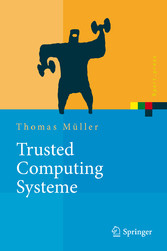Suchen und Finden
Vorwort
6
Inhaltsverzeichnis
9
Abbildungsverzeichnis
13
Tabellenverzeichnis
15
Kapitel 1 Einleitung
16
1.1 Motivation
16
1.2 Ziele des Buches
17
1.3 Gliederung des Buches
18
Kapitel 2 Grundlagen
19
2.1 CPU-Ringe
19
2.2 Verwendung der CPU-Ringe
21
2.3 Virtualisierung und die CPU-Ringe
22
2.4 Zero-Knowledge-Beweis7
24
2.5 Clark-Wilson-Integritätsmodell8
25
Kapitel 3 Trusted Computing
27
3.1 Definition des Begriffs „Trusted Computing“
28
3.2 Ziele des Trusted Computing
30
3.3 Das Trusted Computing System (TCS)
33
3.3.1 Die Trusted Computing Platform (TCP)
35
3.3.2 Das Trusted Operating System (TOS)
35
3.3.3 Die Trusted Computing Base (TCB)
35
3.4 Trusted Computing und Secure Computing
36
Kapitel 4 Die TCP der Trusted Computing Group
38
4.1 PC-Referenzarchitektur
39
4.2 Trusted Building Block (TBB)
40
4.2.1 Root of Trust for Measurement (RTM)
41
4.2.2 Root of Trust for Reporting (RTR)
41
4.2.3 Root of Trust for Storage (RTS)
42
4.3 Das Trusted Platform Module (TPM)
42
4.3.1 TPM-Einheiten
44
4.3.2 TPM-Zugriffskontrolle und Kommunikationsprotokoll
50
4.3.3 TPM-Initialisierung
53
4.3.4 Betriebszustände des TPM (Opt-In)
54
4.3.5 Erweiterte TPM-Konfiguration (Opt-In)
56
4.3.6 TPM-Eigentümer einrichten und entfernen
57
4.3.7 TPM-Schlüsseltypen und Schlüsselverwaltung
59
4.3.8 TPM-Selbstschutzmaßnahmen (Tamper-Resistant)
63
4.4 Sicherheitsfunktionen der TCP
64
4.4.1 Integrity Measurement, Storage and Reporting
64
4.4.2 Initialisierung der Chain of Trust
65
4.4.3 Remote Attestation
68
4.4.4 Kryptographische Operationen
69
4.5 Identität der TCP und entstehende Datenschutzprobleme
70
4.5.1 Erzeugung eines Attestation-Identity-Zertifikats
71
4.5.2 Direct Anonymous Attestation (DAA)
73
4.5.3 Löschen des Endorsement Key
73
4.5.4 Deaktivieren des TPM
74
4.6 Plattform-Zertifikate (Platform Credentials)
74
4.7 Probleme und Einschränkungen der TCP
76
Kapitel 5 Erweiterungen und Alternativen zur TCG
78
5.1 Intel Trusted Execution Technology (TXT)
78
5.2 AMD Presidio Technology
81
5.3 IBM SecureBlue
82
Kapitel 6 Anforderungen an vertrauenswürdige Betriebssysteme
83
6.1 Dynamic Chain of Trust (Integrity Measurement)
83
6.2 Dynamic Chain of Trust (Integrity Protection)
84
6.3 Bewertung der Systemintegrität (Integrity Validation)
85
6.4 Remote Attestation (Remote Integrity Validation)
86
6.5 Trusted Software Stack
87
6.5.1 TPM Device Driver
88
6.5.2 TCG Device Driver Library (TDDL/TDDLI)
88
6.5.3 TSS Core Services (TCS/TCSI)
89
6.5.4 TCG Service Provider (TSP/TSPI)
89
6.5.5 Einsatzszenarien des TSS
90
6.6 Protected Execution
91
6.7 Trusted-GUI und Trusted Input/Output
92
Kapitel 7 Trusted-Computing-Infrastruktur
94
7.1 Public Key Infrastructure (PKI)
95
7.1.1 Ausstellung der Plattform-Zertifikate
95
7.1.2 Ausstellung der AIK-Zertifikate
96
7.1.3 Verwendung der AIK-Zertifikate
97
7.1.4 Zusammenfassung
99
7.2 Certificate-Management-Protokoll
100
7.3 Remote-Attestation-Protokoll
100
Kapitel 8 Theoretische und praktische Lösungsansätze
101
8.1 Integrity Measurement und Integrity Protection
101
8.1.1 AEGIS
101
8.1.2 SEBOS
102
8.1.3 Copilot
103
8.1.4 Trusted Grub
104
8.1.5 IBM Integrity Measurement Architecture (IMA)
105
8.1.6 BIND – Binding Instructions and Data
108
8.2 Remote Attestation
110
8.2.1 Trusted Network Connect (TNC)
110
8.2.2 Microsoft Network Access Protection (NAP)
112
8.2.3 Cisco Network Admission Control (NAC)
113
8.2.4 Property-Based Attestation
114
8.2.5 WS-Attestation
115
8.2.6 Sicherheit des Attestation-Protokolls
118
8.3 Trusted Software Stack (TSS)
120
8.3.1 TrouSerS
120
8.3.2 Trusted Java
121
8.3.3 TPM/J
121
8.4 Protected Execution
121
8.4.1 Terra Architecture
123
8.4.2 Nizza Architecture
125
8.4.3 Perseus Architecture
128
8.4.4 Xen-Hypervisor-Erweiterungen
130
8.5 Trusted Graphical User Interface (Trusted-GUI)
132
8.5.1 Dynamic Security Skins
132
8.5.2 Nitpicker – Overlay Window Management
133
Kapitel 9 Trusted-Computing-Systeme
136
9.1 European Multilaterally Secure Computing Base
136
9.2 Open Trusted Computing
137
9.3 Intel Virtual Appliances/RedHat Embedded IT Software (EIT)
137
Kapitel 10 Fazit
140
Kapitel 11 Trusted Computing mitWindows Vista
142
11.1 Die Geschichte vonWindows Vista
143
11.2 Sicherheitsfunktionen inWindows Vista
144
11.3 Windows Vista TPM Support
145
11.4 Secure Startup und Full Volume Encryption (FVE) – BitLocker
146
11.5 Kernel Integrity Checks/Driver Signing (nur 64-Bit-Versionen)
149
11.6 Windows Resource Protection (WRP)
152
11.7 PatchGuard (nur 64-Bit-Versionen)
153
11.8 User Account Control
153
11.8.1 User Account Protection (UAP)
154
11.8.2 Mandatory Integrity Control (MIC)
156
11.8.3 Secure Desktop (Trusted Path)
157
11.8.4 UI Privilege Isolation (UIPI)
159
11.9 Windows Service Hardening
159
11.10 Zusammenfassung und Schlussfolgerung
160
Literaturverzeichnis
162
Sachverzeichnis
167
Alle Preise verstehen sich inklusive der gesetzlichen MwSt.












